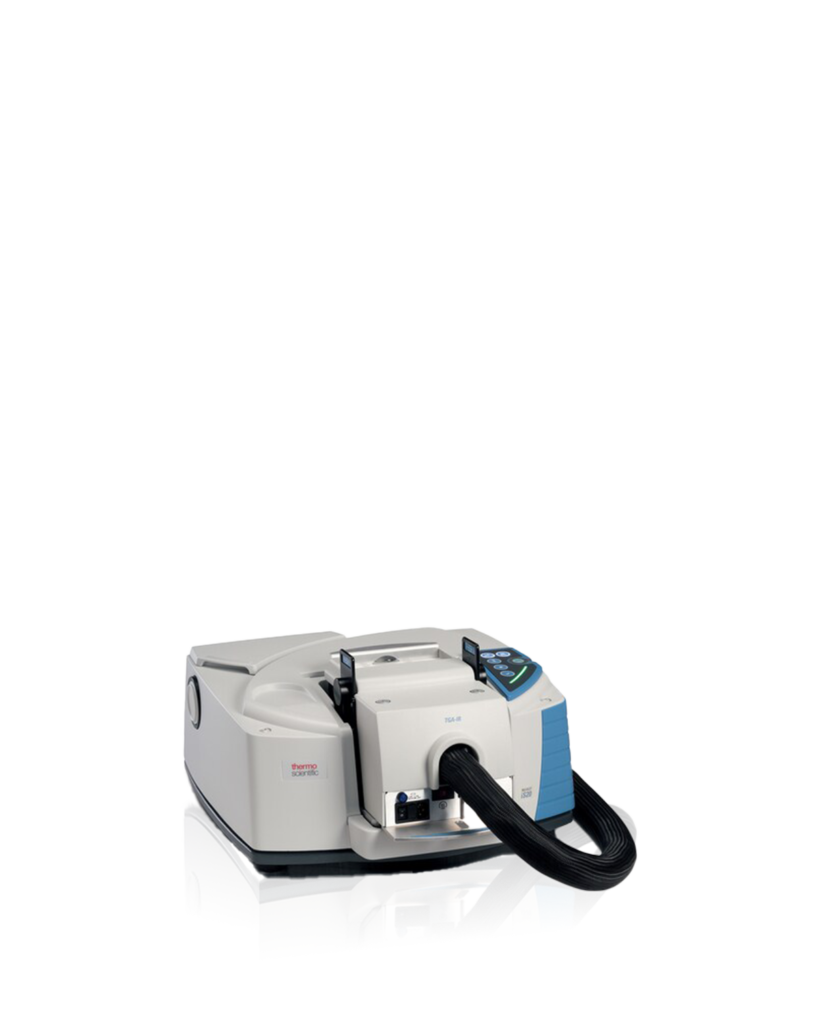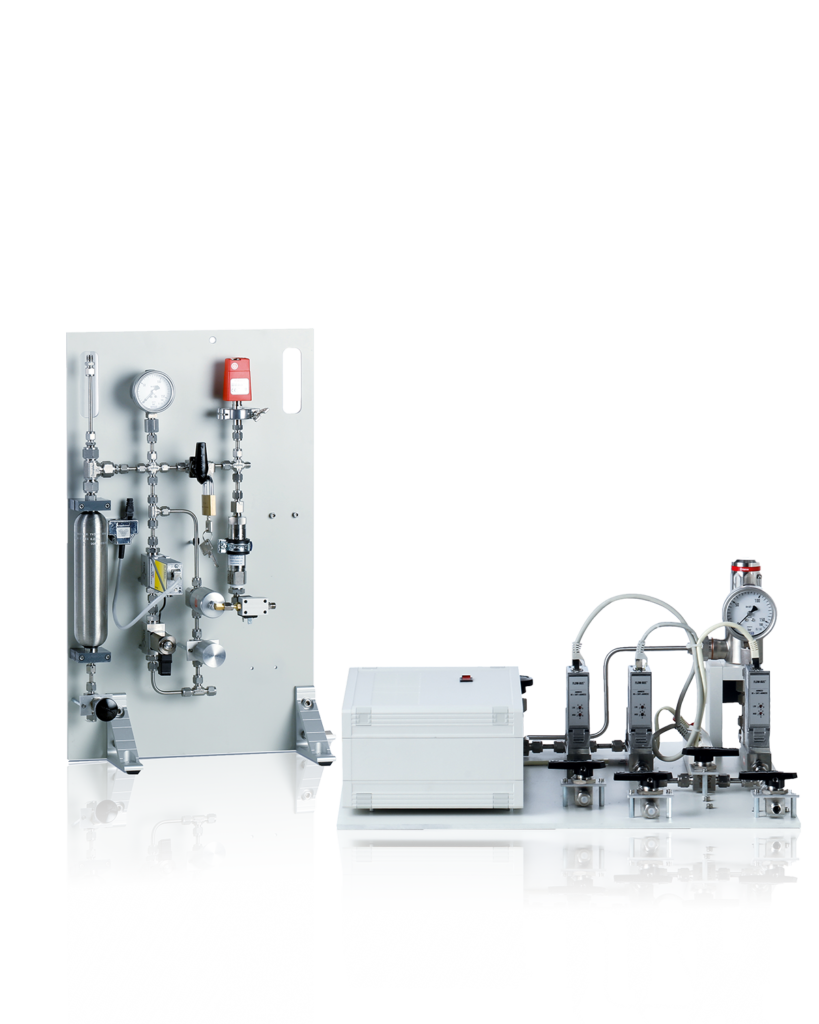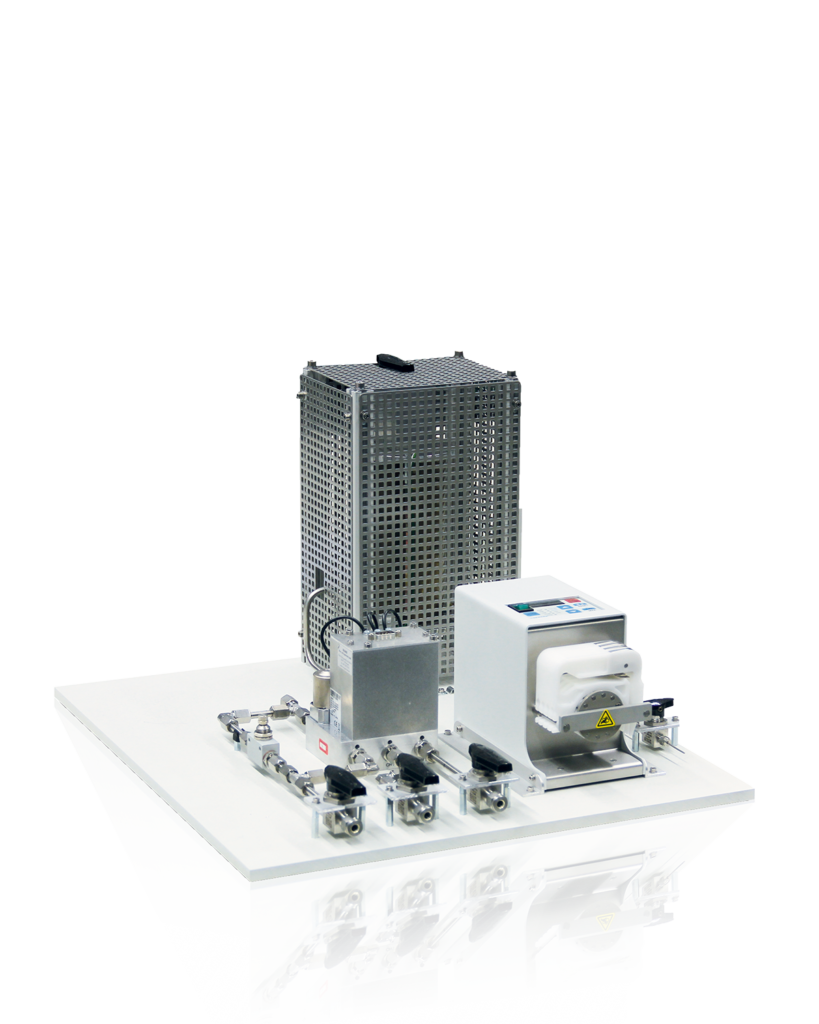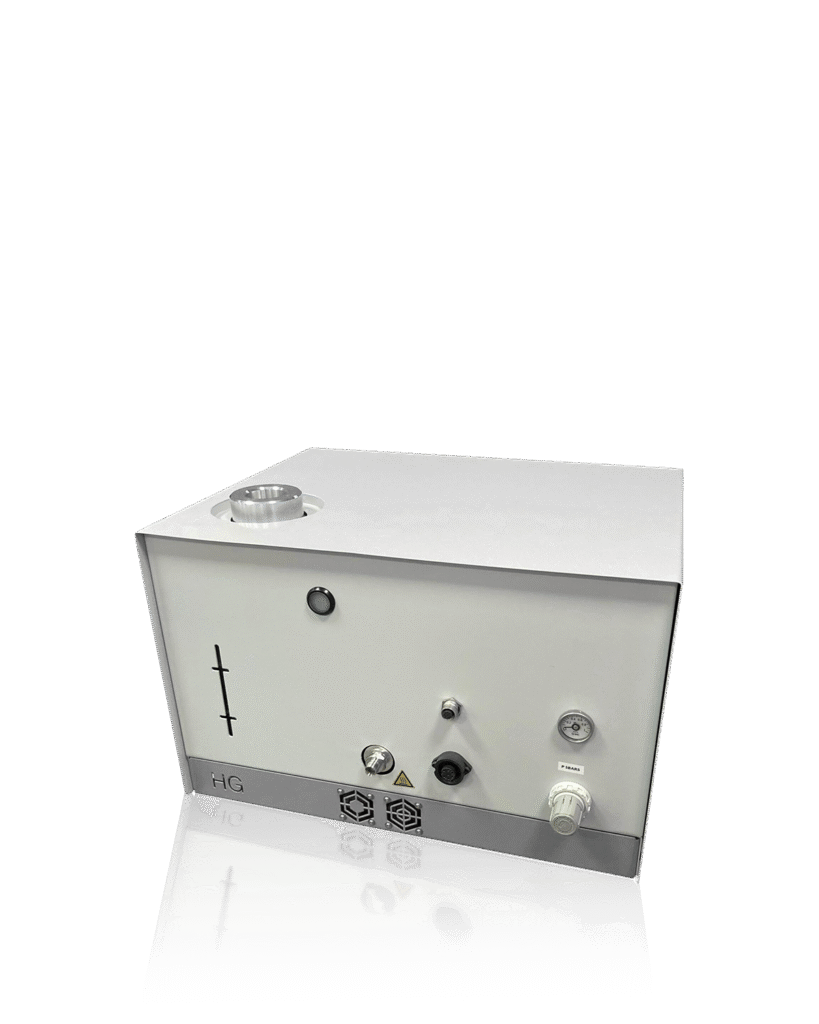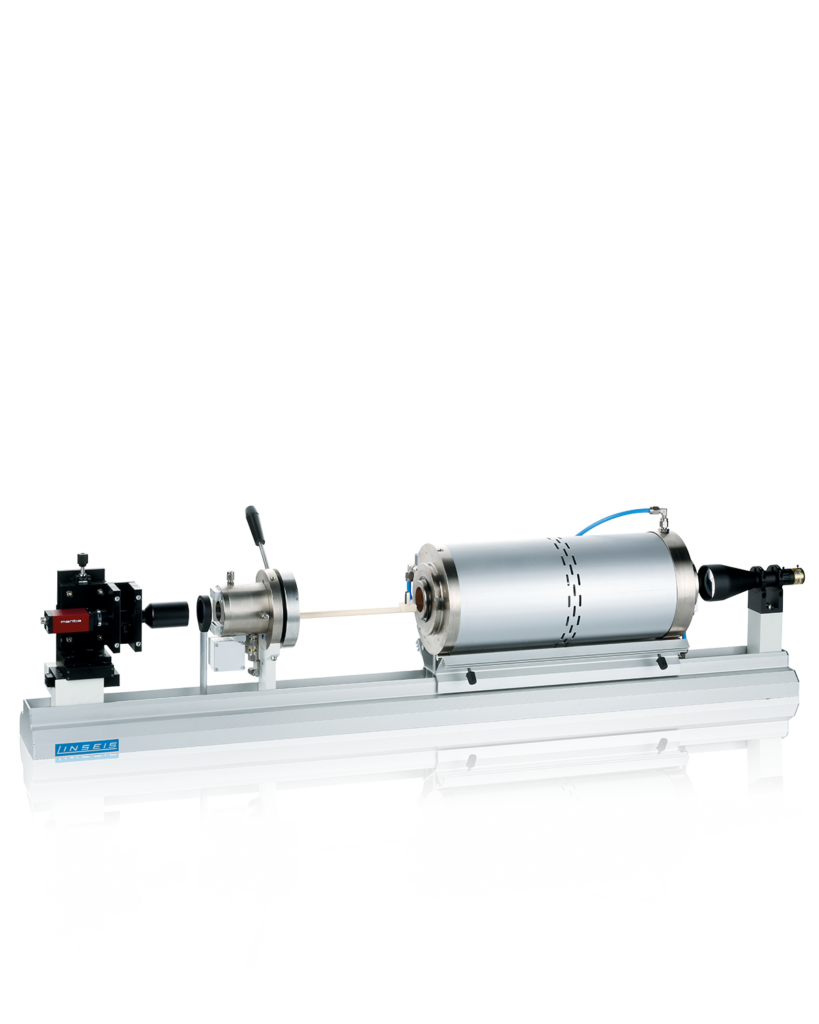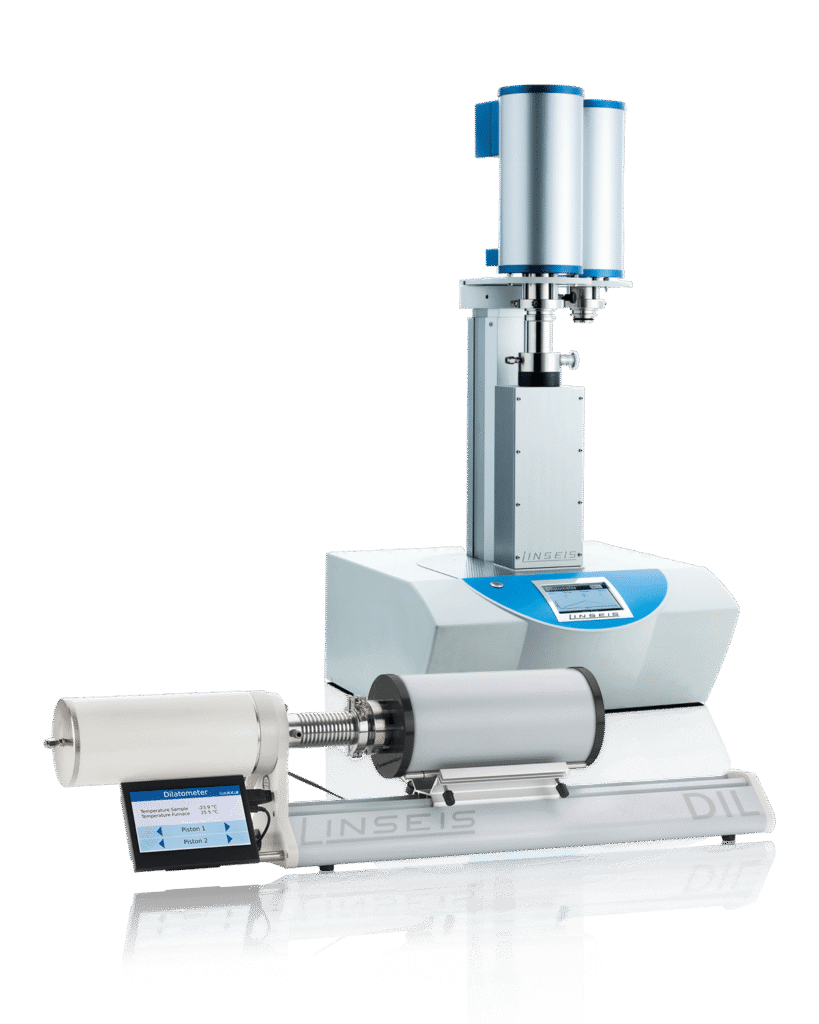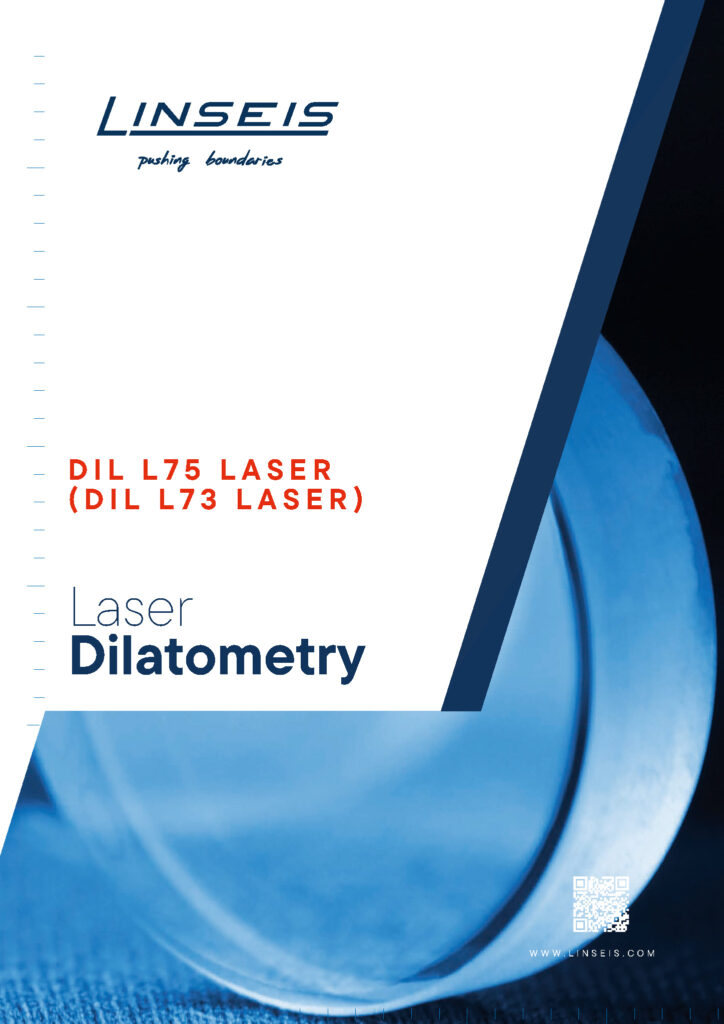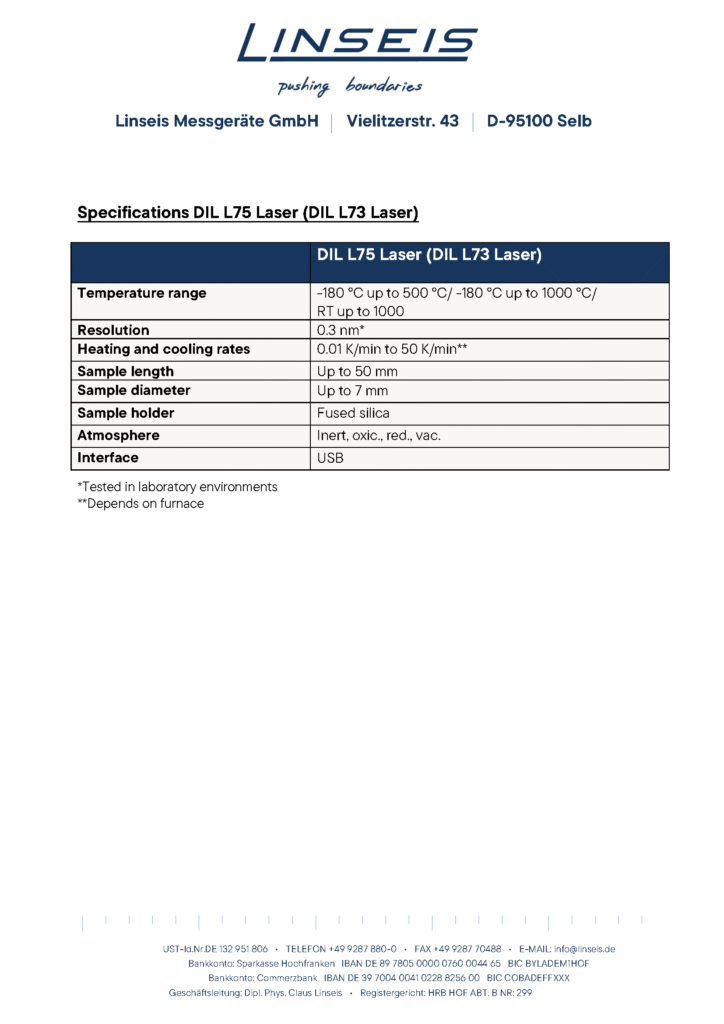DIL L75 Laser (DIL L73 Laser): High-precision laser dilatometry
The LINSEIS DIL L75 Laser (DIL L73 Laser) is a high-end laser dilatometer for ultra-precise, contact-free measurement of thermal expansion and dimensional changes. Using interferometric laser technology with sub-nanometer resolution (up to 0.3 nm), the system enables absolute length measurements with exceptional accuracy and long-term stability.
Designed for maximum versatility, the DIL L75 Laser (DIL L73 Laser) allows analyses under vacuum, inert, reducing or oxidizing atmospheres across a wide temperature range from –180 °C to 1000 °C. Its vertical design, advanced furnace concept and intuitive LINSEIS software ensure reproducible results and simple operation — ideal for research and quality control of ceramics, metals, polymers and composites.
Unique Features

Laser interferometry for absolute length measurement
The DIL L75 Laser (DIL L73 Laser) uses a frequency-stabilized helium–neon laser and a homodyne Michelson interferometer to measure absolute length changes without mechanical contact. This results in a resolution of up to 0.3 nm and exceptional long-term stability.
Contact-free measurement principle
The non-contact laser setup eliminates mechanical influences such as friction or hysteresis. This ensures maximum precision, even for delicate, reflective, or irregular sample surfaces.
Vacuum- and pressure-tight measuring chamber
The closed measuring system allows analyses under vacuum, inert, oxidizing, reducing, or humidified conditions — ideal for sensitive or reactive materials.

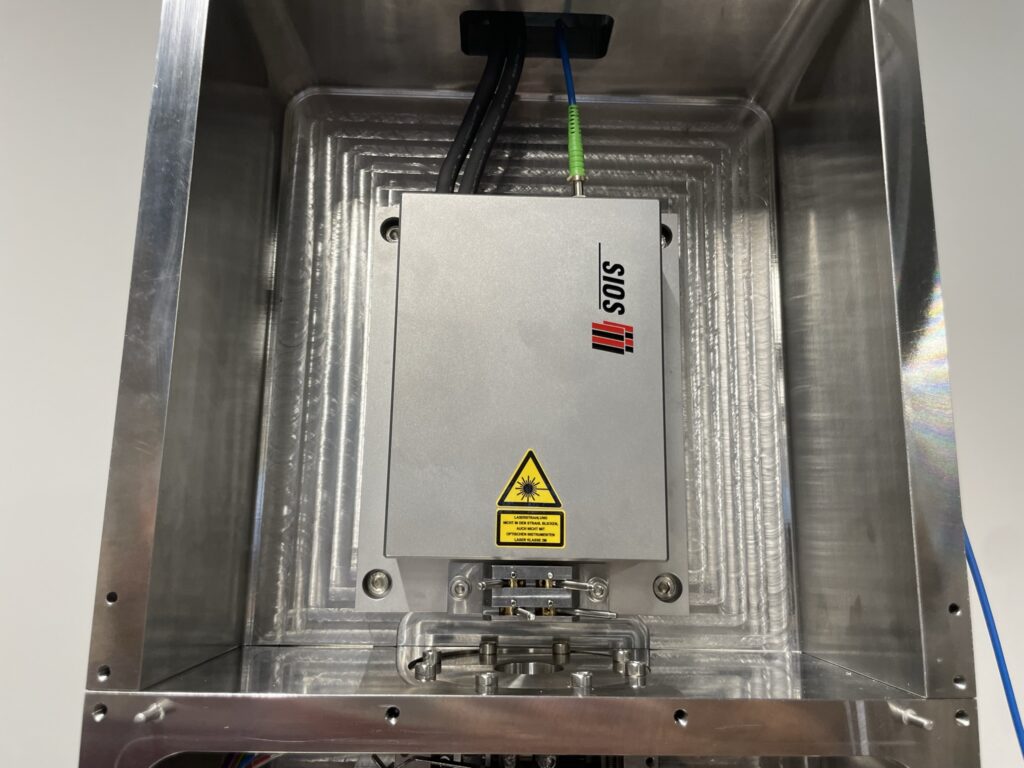
High reproducibility and signal stability
Automatic correction algorithms for offset, amplitude, and frequency minimize drift and noise, ensuring consistent and reproducible measurement results over long periods.
Vertical design for reliable measurement geometry
The vertical configuration uses gravity as a reference, guaranteeing reproducible contact pressure and stable optical alignment throughout the measurement.
Intuitive LINSEIS software platform
The integrated LiEAP software combines temperature control, data acquisition, and evaluation in one platform. It offers automated calibration, rate-controlled sintering (RCS), and multi-method analysis across DIL, DSC, TGA, and STA systems.
Precision without contact
The DIL L75 Laser (DIL L73 Laser) enables absolute, contact-free measurement of dimensional changes using laser interferometry.
Its interferometric design eliminates mechanical distortion, ensuring ultra-stable results even with minimal sample expansion.
Designed for complex materials
Engineered for research and quality control, the DIL L75 Laser (DIL L73 Laser) allows precise analysis of ceramics, metals, polymers, and composites under vacuum, inert or reactive atmospheres.
Its flexible furnace configurations and stable optical setup ensure reproducible results across a wide temperature range.
Advanced metrology architecture
The DIL L75 Laser (DIL L73 Laser) is built around a closed, vibration-stable metrology frame with integrated laser optics.
This design minimizes drift and guarantees linear signal response — a key advantage for long-term measurements and calibration-free operation.
Highlights



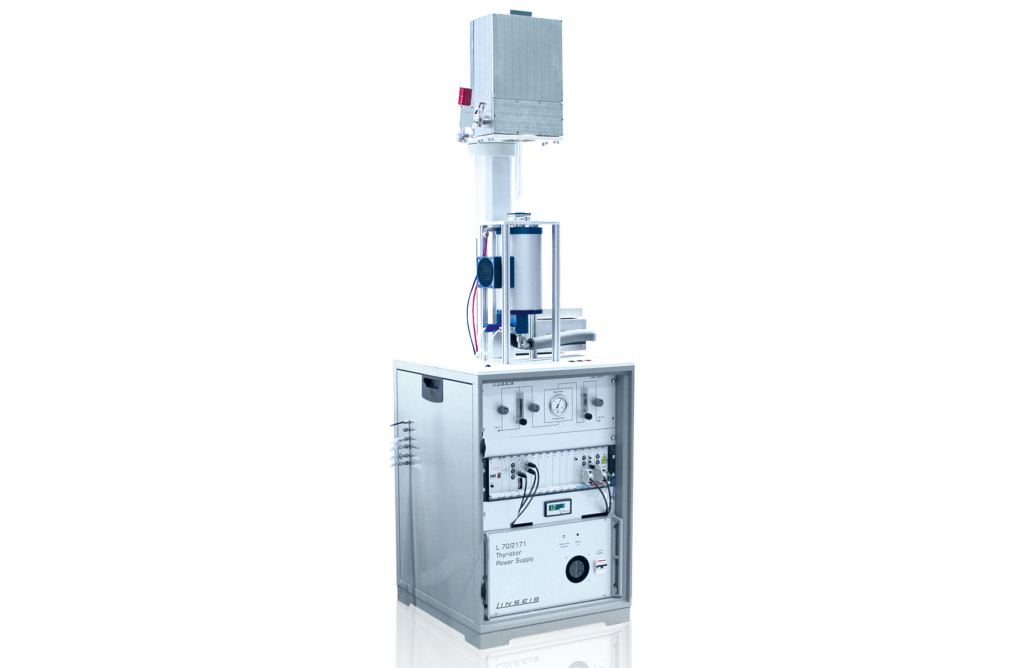
High precision:
laser interferometer for
sub-nanometer resolution
Wide temperature range
Operation from RT to 1000 °C/
-180 °C to 500 °C/
-180 °C to 1000 °C/
Extended cooling options:
Air, liquid, nitrogen or closed
cooling circuit.
Contactless laser measurement
Adjustable measuring force on the
sample, non-contact determination of the expansion
User-friendly software:
Comprehensive data
analysis and reporting.
Key Features

Absolute, contact-free measurement
Laser interferometry enables direct, contact-free length measurement with sub-nanometer precision — ideal for sensitive or irregular samples.

Exceptional stability and reproducibility
Drift-free measurement signals and a vibration-stable frame ensure consistent accuracy, even in long-term or high-temperature experiments.
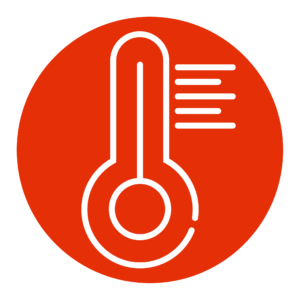
Wide application range
Operates from –180 °C to 1000 °C under vacuum, inert, reducing, or oxidizing atmospheres for universal materials testing.

Integrated LINSEIS platform
The integrated LINSEIS software offers a comprehensive solution that combines hardware and software for maximum process reliability and precision. The standardized platform enables seamless integration of components and devices from external partners – for a particularly robust and reliable overall system.
Questions? We're just a call away!
+1 (609) 223 2070
+49 (0) 9287/880 0
Our service is available Monday to
Thursday from 8-16 o’clock
and Friday from 8-12 o’clock.
We are here for you!
Specifications

Resolution: up to 0.3 nm

Temperature range: –180 °C to 1000 °C

Heating/cooling rates: 0.01 K/min to 50 K/min
Discover our ultra-precise Laser Dilatometer – developed for absolute measurement accuracy:
- Resolution: up to 0.3 nm (tested in laboratory environments)
- Temperature range: –180 °C to 1000 °C (depending on furnace configuration)
- Heating and cooling rates: 0.01 to 50 K/min
- Sample dimensions: up to 50 mm length and 7 mm diameter
- Atmospheres: Vacuum, inert, oxidizing or reducing conditions

Recommended Equipment
EGA - Evolved Gas Analysis
Gas Dosing & Gas Safety
Water Vapor & Relative Humidity
Method
Dilatometry
Dilatometry measures the dimensional changes of a material as a function of temperature or time under precisely controlled conditions. The method provides direct information about thermal expansion, shrinkage, sintering behavior and phase transitions — key parameters for understanding thermo-mechanical properties.
During a DIL measurement, the change in length (ΔL) of the sample is recorded continuously while temperature and atmosphere are varied in a defined program. From this, coefficients of thermal expansion (CTE) and other temperature-dependent parameters can be determined with high precision.
Because the measurement is performed directly on the sample — without destructive preparation — even subtle transitions such as glass transition, softening, or densification processes can be precisely detected.
Laser-based dilatometers, such as the LINSEIS DIL L75 Laser (DIL L73 Laser), enable absolute, contact-free length measurements with sub-nanometer resolution. This eliminates mechanical influences such as friction or drift and ensures reproducible results across all materials and geometries.
Dilatometry is essential in materials science, ceramics, metallurgy, and polymer research. It supports reliable characterization of dimensional stability, sintering kinetics, and process optimization under realistic thermal conditions.

Functional principle of the DIL L75 Laser (DIL L73 Laser)
The DIL L75 Laser (DIL L73 Laser) determines the thermal expansion and dimensional changes of a sample with absolute precision using laser interferometry. The sample is positioned vertically inside a vacuum- and pressure-tight measuring chamber and subjected to a defined heating or cooling program.
A frequency-stabilized helium–neon laser generates two coherent beams that are superimposed in a Michelson interferometer. The resulting interference pattern changes proportionally to the thermal expansion or shrinkage of the sample. From the phase shift of the interference signal, the absolute length change (ΔL) is determined in real time — without mechanical contact.
This contact-free measuring principle completely eliminates influences such as friction, hysteresis or drift that are typical for conventional push-rod systems. It enables a sub-nanometer resolution (up to 0.3 nm) and ensures excellent reproducibility, even for materials with very low expansion coefficients or sensitive surfaces.
The measurement can be performed under vacuum, inert, oxidizing or reducing atmospheres, and temperature control is achieved via an advanced LINSEIS furnace system with homogeneous heat distribution. The result is a precise, linear expansion curve that provides valuable insights into thermal stability, phase transitions, sintering behavior and material transformations.
Measured variables with Dilatometry
Possibilities of thermal analysis using Dilatometry:
A head start with the DIL L75 Laser (DIL L73 Laser) – precision and flexibility for every application
DIL L74 HM
Questions? We're just a call away!
+1 (609) 223 2070
+49 (0) 9287/880 0
Our service is available Monday to
Thursday from 8-16 o’clock
and Friday from 8-12 o’clock.
We are here for you!
DIL L75 Laser (DIL L73 Laser) explained - function, use and capabilities
What is the difference between a dilatometer and a TMA?
A dilatometer measures absolute dimensional changes (ΔL) of a sample as a function of temperature or time, typically under minimal mechanical load.
A thermomechanical analyzer (TMA) applies a defined force to the sample and records deformation, which also includes effects from viscoelastic or plastic behavior.
Dilatometry is therefore ideal for thermal expansion, shrinkage, and sintering studies, while TMA focuses on mechanical deformation under load.
What are the advantages of the DIL L75 Laser (DIL L73 Laser) compared to conventional systems?
The DIL L75 Laser (DIL L73 Laser) uses laser interferometry to measure absolute length changes without mechanical contact.
This eliminates errors caused by friction, hysteresis, or drift, providing sub-nanometer resolution (up to 0.3 nm) and excellent reproducibility — even for reflective or delicate samples.
What is the difference between a laser dilatometer and one with an optical encoder?
Optical encoders measure relative displacement using reflected light and mechanical contact (push rod).
A laser dilatometer, in contrast, determines absolute expansion directly from the interference phase shift of coherent laser beams.
This results in higher accuracy, no mechanical wear, and no need for calibration standards.
What are the key requirements for sample preparation?
Samples should have a smooth, parallel surface and well-defined dimensions for reproducible results.
The DIL L75 Laser (DIL L73 Laser) allows flexible geometries up to 50 mm in length and 7 mm in diameter, and even reflective or non-reflective surfaces can be analyzed without modification thanks to the contact-free laser principle.
What types of detectors are used to measure length change in dilatometers?
Traditional systems use LVDT (Linear Variable Differential Transformer) or optical encoder sensors.
Laser dilatometers, however, use interferometric detectors that measure phase shifts of light with extreme precision — achieving resolutions far beyond mechanical sensors.
How much does an DIL L75 Laser (DIL L73 Laser) cost?
The price of an DIL L75 Laser (DIL L73 Laser) system depends on the selected configuration and additional options, such as the temperature range, furnace type, cooling system, automation features, or specialized measurement modes. Since each system can be tailored to your specific application requirements, the cost can vary significantly.
For an exact quotation, please use our contact form to send us your requirements – we will be happy to prepare a customized offer for you.
What is the delivery time for an DIL L75 Laser (DIL L73 Laser)?
The delivery time for an DIL L75 Laser (DIL L73 Laser) largely depends on the chosen options and configuration. Additional features such as special furnaces, extended temperature ranges, automation, or custom adaptations may increase production and preparation time and therefore extend the delivery period.
Please contact us via our contact form to receive an accurate delivery time estimate based on your individual requirements.
How does the laser interferometry of the DIL L75 Laser (DIL L73 Laser) work?
A frequency-stabilized helium–neon laser generates two coherent beams that are superimposed in a Michelson interferometer.
The resulting interference pattern shifts proportionally to the sample’s expansion or shrinkage.
From this phase shift, the absolute length change is calculated with sub-nanometer precision — completely contact-free.
Which atmospheres can be used with the DIL L75 Laser (DIL L73 Laser)?
The system supports measurements under vacuum, inert, reducing, oxidizing, and even humidified atmospheres.
Optional gas dosing and safety modules as well as water vapor or humidity systems allow precise environmental control for advanced material studies.
Software
Making values visible and comparable
The powerful LINSEIS thermal analysis software, based on Microsoft® Windows®, performs all key tasks for the preparation, execution and evaluation of thermoanalytical experiments.
Developed by LINSEIS software specialists and application experts, the system offers a robust, user-friendly solution for instrument control, data acquisition, and advanced evaluation.
All settings and functions are fully integrated into a single intuitive platform — the LINSEIS Evaluation and Acquisition Platform (LiEAP).
Dilatometer functions
Glass transition and softening point determination
Automatic softening point switch-off (freely adjustable for system protection)
Display of absolute or relative shrinkage / expansion
Calculation of technical and physical expansion coefficients (αₜ, αₚ)
Rate-controlled sintering (RCS) software option
Sintering process and density evaluation
Automatic correction routines (temperature, zero curve, drift)
Automatic zero-point adjustment and punch contact pressure control
General functions
Real-time color display and freely configurable axis settings
Automatic and manual scaling, with zoom and cursor options
Mathematical tools (first / second derivative, curve arithmetic)
Statistical evaluation (mean curve with confidence interval)
Multi-user and multitasking functionality
Comparison of any number of curves
Automatic calculation of zero curves and α-values (α_phys, α_tech, L/L₀)
Data export to Excel® and ASCII formats
Integrated online help and documentation
Optional extensions
Rate Controlled Sintering (RCS) module
Kinetic and lifetime prediction packages
Multi-method compatibility for DSC, TGA, STA, DIL and TMA instruments
Thermal Library for fast identification of known reference materials
LINSEIS Thermal Library
The LINSEIS Thermal Library software package is an option for the well-known, user-friendly LINSEIS Platinum evaluation software, which is integrated in almost all our devices. The Thermal Library allows you to compare the complete curves with a database containing thousands of references and standard materials in just 1-2 seconds.
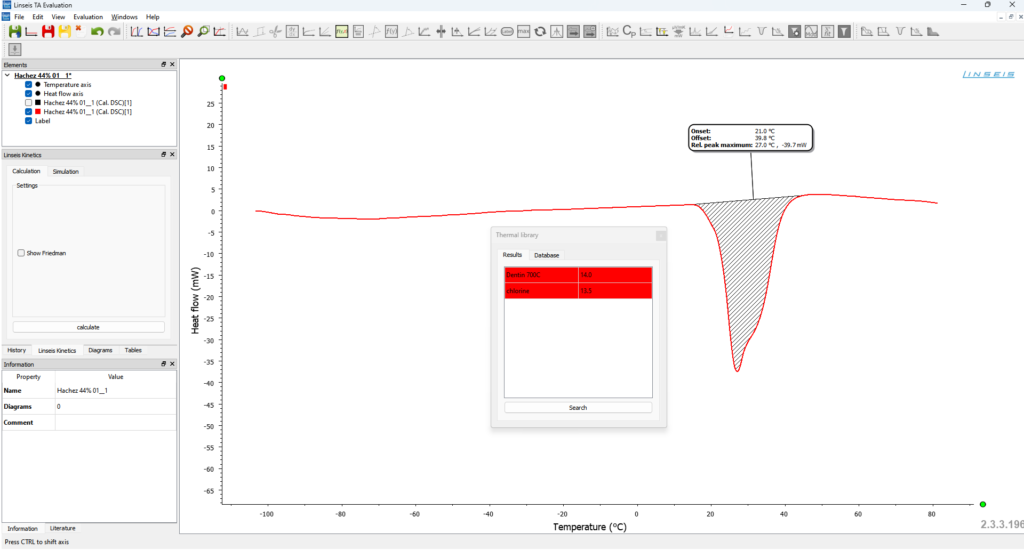
Multi-instrument
All LINSEIS instruments DSC, DIL, STA, HFM, LFA, etc. can be controlled via a software template.
Multilingual
Our software is available in many different user-interchangeable languages, such as: English, Spanish, French, German, Chinese, Korean, Japanese, etc.
Report generator
Convenient template selection for creating individual measurement reports.
Multi-user
The administrator can set up different user levels with different rights to operate the device. An optional log file is also available.
Kinetic software
Kinetic analysis of DSC, DTA, TGA, EGA (TG-MS, TG-FTIR) data to investigate the thermal behavior of raw materials and products.
Database
The state-of-the-art database enables simple data management with up to 1000 data records.
Applications
Metals and Alloys
Metals and alloys used in industrial applications must exhibit precisely defined physical and mechanical properties. Parameters such as hardness, strength, thermal expansion, and resistance to oxidation or corrosion must be optimized to meet the demands of their intended application and ensure long-term stability.
Since pure metals often do not provide the required performance, they are alloyed with additional elements such as semi-metals or non-metals. These alloy systems allow targeted adjustment of thermophysical and mechanical properties, enabling the development of advanced materials for aerospace, automotive, and electronic applications.
Dilatometry plays a central role in the characterization of such materials. It allows the precise determination of linear thermal expansion, sintering behavior, phase transformations, and softening or transformation temperatures. These parameters are crucial for evaluating the dimensional stability and thermal performance of metals and alloys under real operating conditions.
With the DIL L75 Laser (DIL L73 Laser), these properties can be measured absolutely and without mechanical contact. The interferometric laser system achieves sub-nanometer resolution (up to 0.3 nm), providing highly reproducible results even for materials with minimal expansion coefficients such as Invar or superalloys.
This makes laser dilatometry an indispensable tool for metallurgical research, quality assurance, and process development in the metal industry.
Application example: Invar dilatometer measurement
An Invar sample was measured and evaluated four times from room temperature to 210°C in air. The reproducibility was determined by comparing the four runs on the laser dilatometer. A reproducibility of 0.01 % of the measuring range was achieved as can be seen in the graphics on the right. The reproducibility was found to be 33 times higher when using the laser dilatometer instead of classical push rod dilatometer. A further advantage is that the laser dilatometer delivers an absolut readout of expansion values and no correction is necessary.
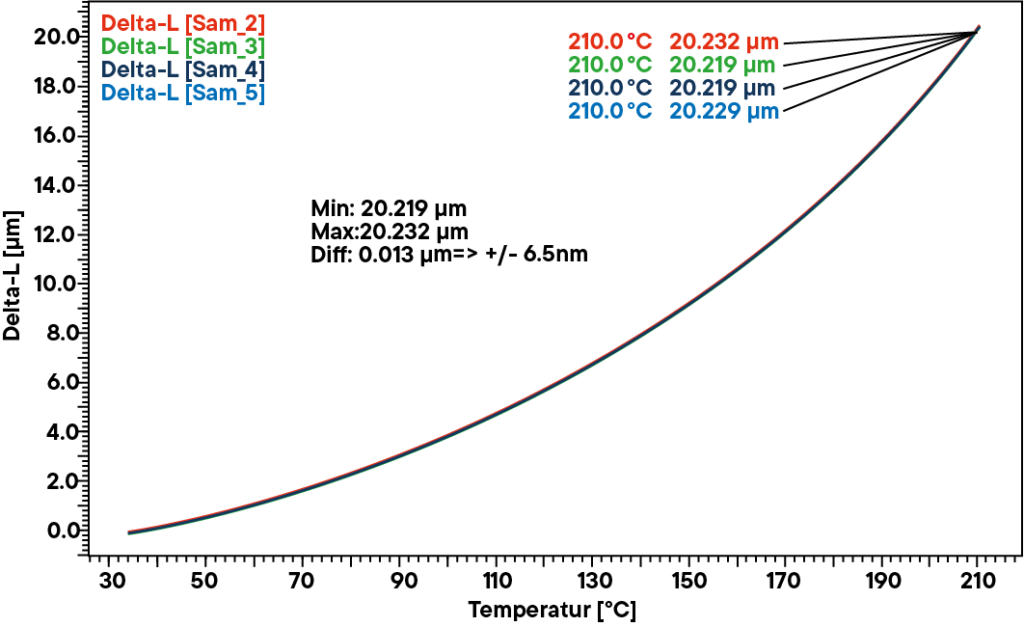
Well informed

